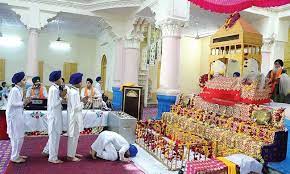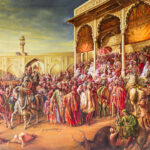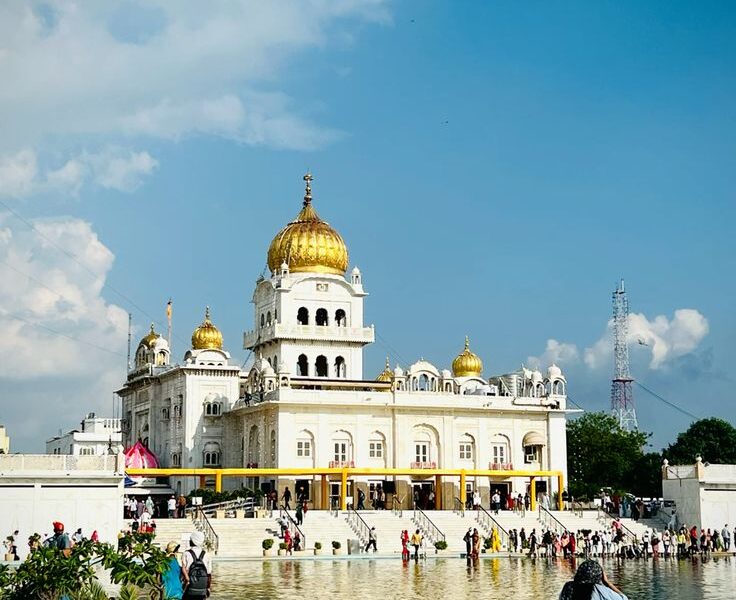The Guru Granth Sahib is fundamental to the life of Sikhs. Eleanor Nesbitt explores Sikh daily prayer, devotional songs, and festivals, as well as the rituals that surround it and its place in the everyday lives and life cycle rites of Sikhs.
The Guru Granth Sahib’s Importance
The Guru Granth Sahib is the Sikh community’s sacred literature and the incarnation of the Guru. It is crucial to the life of committed Sikhs, both physically present in the gurdwara and as the ultimate spiritual authority for Sikhs. Furthermore, faithful Sikhs hear or repeat scriptural portions that comprise their daily prayers every day, and the Guru Granth Sahib also plays an important role in life cycle rites and celebrations.
Because the Granth Sahib is the spiritual teacher of Sikhs, their Guru, it is revered as a sovereign centuries ago in India. The 1430-page book is enthroned beneath a canopy and rests on cushions on the palki (literally palanquin i.e. the special stand). When it is open and being read, an attendant waves a chauri above it: the chauri is a fan made of yak tail hair placed in a wooden handle. When not being read, the volume is covered by crimson and gold cloths known as rumalas, and in many gurdwaras, it is ceremonially brought to a separate bedroom where it is set to rest after the late evening prayer.
Sikhs who keep the Guru Granth Sahib at home honour it in its chamber. Strict procedures are followed whenever a copy is temporarily stored in a Sikh’s home for the duration of a path (reading of the complete volume), such as no non-vegetarian food being kept or cooked. In other words, the house is temporarily converted into a gurdwara.
The reading is frequently an Akhand path (continuous, 48-hour reading of the entire Guru Granth Sahib). Sikhs frequently set up an Akhand path to bless a new home or to commemorate a significant birthday or another family event. Many families prefer to do the Akhand path in a gurdwara rather than at home. In any case, reader relays are organized, and the family provides free vegetarian hospitality for attendees. When faced with a quandary, Sikhs look to the Guru Granth Sahib for advice. The time-honored way is to open the book at random and take the words of the hymn at the top of the left-hand page as the Guru’s response. A vak is a type of guidance. Every day, a vak (also known as hukamnama, or order) is taken in every gurdwara, and the words are displayed for all to read.
Sikhs are increasingly using the internet to consult the Guru Granth Sahib: for example, they can read or hear the daily hukamnama from Amritsar’s Harmandir Sahib (the Golden Temple), as well as read and search their scripture’s original text or translation. In the gurdwara, the words are frequently projected onto screens, along with a translation, so that the Sangat (congregation) can read them as they are uttered or sung.
Sikh life cycle ceremonies
A child’s name is decided in devout Sikh families based on a vak, as the first word of the hymn on the left-hand page offers the initial for the infant’s given name. If the first word started with’s,’ names like Sukhvinder, Satnam, and Simran might be considered. Most Sikh forenames are unisex: in a boy’s case his name will be stated as, for example, ‘Satnam Singh’ while a girl would be ‘Satnam Kaur’. The Guru Granth Sahib is literally at the core of the Anand Karaj (marriage) rite, as the couple walks around it clockwise four times, joined by a scarf that drapes over the groom’s right shoulder, with the groom leading the way and the bride close behind him. Her close male relatives assist her on her journey. The officiant reads one verse of Guru Ram Das’s hymn Lavan (Guru Granth Sahib, page 773) before each round, and the ragis (musicians) sing it again as the bridegroom follows the bride around the palki.
The Lavan’s stanzas evoke the evolution of the human soul, and the enthroned scripture bears witness to the union. Following the Ardas (congregational prayer) and the giving of karah prasad, the ceremony closes with six verses of Anand Sahib (Guru Amar Das’ composition on pages 917-922 of Guru Granth Sahib) (made from ghee, sugar, wheat flour, and water). The late evening prayers (kirtan sohilla) are chanted at a Sikh burial, and the entire Guru Granth Sahib is read over up to 10 days following someone’s death (this is known as a Sahaj path or sadharan path). The ashes of the deceased are immersed in a river, in many cases the Satluj River in Kiratpur, north India. Some Sikhs demonstrate their devotion to the Guru by becoming formally initiated into the Khalsa (the body of Sikhs who maintain a discipline that is attributed to the tenth Guru). They vow to keep the “five Ks” as markers of their dedication. This is accomplished through a rite known as khande di pahul (initiation with the double-edged sword) or Amrit chhakana. The water of initiation is referred to as Amrit (meaning “deathless”). The khande di pahul process is thought to have originated in 1699 when Guru Gobind Singh initiated five men who volunteered their life for him.








